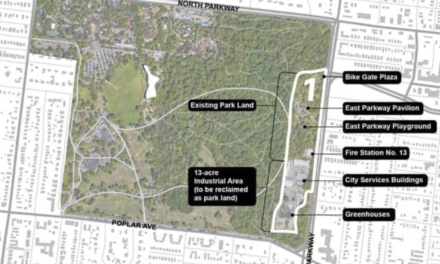Part I was posted September 29:
Today, we have many visions for key sectors that will determine the future of Memphis. The school reform agenda – with charters, Achievement School District, IZone schools, Teacher Town, Knowledge Quest, and more – has national significance, and if it results in more Memphis students getting college degrees, it may well be the most important force shaping the future.
There’s a vision for arts coming into focus – Hattiloo Theatre, the new addition to Orpheum Theater, Forge, the arts districts on Broad Avenue and South Main, Memphis Slim’s House, ArtsAccelerator, too many grassroots arts events to count, and more. There’s a new neighborhood vision built on renewed ownership and an urgency to act by its residents – Broad Avenue, the EDGE, Community LIFT, Frayser Neighborhood Council, Binghampton, tactical urbanism, and much more.
There’s a bold vision for green assets – Shelby Farms Park and Greenline, Mid-South Greenprinting Plan, Main to Main, paddling the Wolf River, bike lanes, and more. There is a new vision of Memphis as a startup city – StartCo, Seed Hatchery, Forge, Greater Memphis Accelerator Consortium, Crews Center for Entrepreneurship, EPIcenter, Bioworks Business Incubator, and more. There are new economic engines under way or planned – Chamber’s moon shots, Bass Pro Shops at The Pyramid, Overton Square, Sears Crosstown, Fairgrounds redevelopment, Graceland expansion, and more.
If we need anything, we need people from all of these initiatives to be talking to each other and finding new ways for all the sectors to be leveraging off each other and maximizing their efforts. But acting on the lessons of the Jobs Conference, perhaps what we need to do is to package all of these important initiatives into something that like the portfolio of projects from the Jobs Conferences give us a sense of what our priorities are going forward.
If there is a theme to all the exciting things going on in Memphis these days, it’s this: Memphis is worth fighting for!
Backing a City of Choice
As for the vision, we’re hard-pressed to think of a better one than the one Memphis Mayor A C Wharton Jr. announced when he was elected mayor: Memphis as a City of Choice.
That vision calls for the creation of a city that attracts people with choices – middle class families and young professionals – but it is also about a city that provides choices for people who don’t have any – the 28% of Memphians living in poverty and the working poor who make up almost half of all Memphians.
All of the activity in Memphis, regardless of the sector, contributes to the accomplishment of that vision, and while City Hall doesn’t always do a good job of connecting its program and projects to this vision, they are nonetheless all are seen and evaluated through the lens of a city of choice, according to Mayor Wharton.
Unfortunately, for City Hall, with an uncooperative Memphis economy, collapsing city finances, unbalanced (and inherited) budget trends that sacrificed neighborhood services to pay for skyrocketing police costs, and volatile decisions about public pensions and retiree health benefits, the Wharton Administration and Memphis City Council have had little ability to make the kind of dramatic investments in quality of life, neighborhood interventions, and improvements to parks and libraries that would move the city toward a city of choice reality.
It’s an unpleasant reality because now, more than ever, Memphis needs an investment plan of a historic size and unprecedented scope, one that could fund major new city assets but also fund small neighborhood-based improvements, one that could improve city parks but also put Memphians to work on city improvement projects.
Investing in the Future
The fact is that if Memphis is worth fighting for, it is also worth investing in.
It’s also that it’s a fact that these are difficult days for cities in general, lacking effective and well-funded urban policies at the state and federal levels. But, smart and successful cities are today making bold bets on their futures.
Austerity philosophies work no better in American cities than they do in Europe, and that’s why we see ambitious riverfronts, major parks, large-scale neighborhood improvement projects, public technologies, and library expansions and improvements, and children’s and teenager centers being undertaken in all kinds of cities as stimulus programs but also as competitive advantages in their futures.
Memphis is at a point where it can’t ignore the need for these investments any longer. Many of its facilities are largely unchanged since the 1960s, and as a result, they are frequently in the wrong places because of population shifts and demographic changes. Most neighborhood libraries were built before there was Internet although libraries’ present lives as information centers include heavy technology demands from patrons. As for city parks, there has been interest in a comprehensive plan for a number of years, including the need to set standards for the types of equipment in various sized parks and to bring all parks up-to-date.
Incremental Is Not Enough
An “Investing in the Future” program gives Memphis an important opportunity to change its narrative and its trajectory, and it’s hard to think of investments that could be more important in attracting talent, in telling middle-class families and young professionals that they should consider Memphis, but most of all, they could send a message to Memphians – particularly children – that their own city values them and is committed to giving their families better options for the future.
Here’s the thing: as Carol Coletta has said for many years, Memphis must achieve more than incremental progress because in the end, we remain in the same relative position with other cities. In other words, with incremental improvement, Memphis will continue to remain in the bottom of most rankings for the most important regional indicators.
Memphis must find the disruptive innovation that catapults it to the middle of city rankings, because it would mean ten billions of dollars in economic expansion and redefine this community.
We need to embrace the rapidly emerging DIY movement and every one of us should assume an active role as enablers.
We need a break from the conventional thinking that limits our considerations of what is possible as we develop a plan based on place, opportunity, and talent.
Power to the People
We need to break free from the business as usual attitudes that lead us to accept things as “good enough for Memphis,” including bad design, poor or no programming in our public realm, and nonexistent connectivity.
We need to quit the Memphis tradition of looking for elected officials to solve our problems. This is much more than a political problem in search of a political answer.
We need to find ways to identify what disruptive innovations are possible rather than investing in another process and report that ultimately tell us what we already know about ourselves and as a result, fails to activate actions backed by a sense of urgency.
We need to break free of ourselves and pursue objectives that might seem unreachable and unattainable, because that’s what we will need to be inspired and united so we can have more than the mediocre future that urban experts predict for us.
The question now is how many of us are willing to be part of making it happen.





I am working on a proposal that proposes that our City start and host a public skateboarding program that would consist of free learn-to-skate clinics and competitions. The program cost the nothing for the City and would be run by community volunteers. I will keep you updated as to how well our efforts are embraced. If the program is adopted it would provide a great example of the City embracing the DIY movement. Let’s hope for the best outcome!